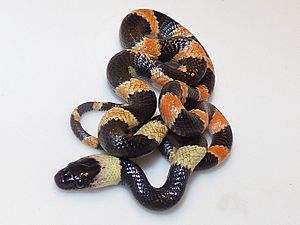Forest flame snake facts for kids
Quick facts for kids Forest flame snake |
|
|---|---|
 |
|
| Dapa, Colombia | |
| Conservation status | |
| Scientific classification | |
| Genus: |
Oxyrhopus
|
| Species: |
petolarius
|
| Synonyms | |
|
|
The Oxyrhopus petolarius, also known as the forest flame snake, is a type of snake. It belongs to the Colubridae family. This snake is found only in South America. There are three different kinds, called subspecies, of this snake.
Contents
Where Does the Forest Flame Snake Live?
The forest flame snake, O. petolarius, lives in central and northern South America. You can also find it in Trinidad and Tobago.
What Kind of Places Does it Like?
This snake prefers to live in forests and savannas. It can be found from sea level up to about 2,000 m (6,600 ft) high.
What Does the Forest Flame Snake Look Like?
Adult forest flame snakes can grow up to 91 cm (36 in) long. This includes their tail, which can be about 22 cm (8.7 in) long.
Their colors can be different. They usually have a mix of red and black rings or bands across their body. Some snakes might have white bands instead of red ones near their head.
The scales on their back are smooth. They are arranged in 19 rows around the middle of their body.
How Does it Hunt?
The forest flame snake has fangs at the back of its mouth. It uses a special liquid, called venom, to help catch its food. This venom is very effective against small animals like anole lizards, which are a common part of its diet.
What Does it Eat?
The forest flame snake eats many different things. Its diet includes:
- Lizards
- Frogs and other amphibians
- Tadpoles
- Small rodents and other small mammals
- Birds and their eggs
- It might also eat other snakes.
How Does it Reproduce?
The forest flame snake lays eggs. This means it is an egg-laying animal.
Different Types of Forest Flame Snakes
Scientists recognize three different types, or subspecies, of the Oxyrhopus petolarius. These include the main type, called the nominotypical subspecies.
- Oxyrhopus petolarius digitalis (Reuss, 1834)
- Oxyrhopus petolarius petola (Linnaeus, 1758)
- Oxyrhopus petolarius sebae (A.M.C. Duméril, Bibron & A.H.A. Duméril, 1854)
Why are Some Names in Parentheses?
When a name is in parentheses, it means that subspecies was first described under a different genus name.
Where Did the Name Come From?
The name sebae for one of the subspecies honors a Dutch naturalist named Albertus Seba.
See also
 In Spanish: Oxyrhopus petolarius para niños
In Spanish: Oxyrhopus petolarius para niños


